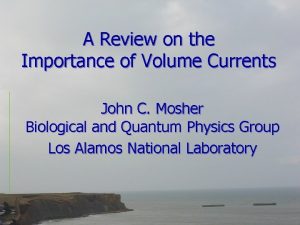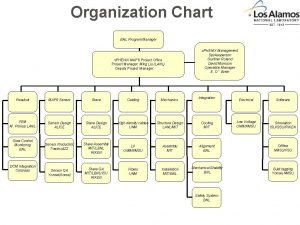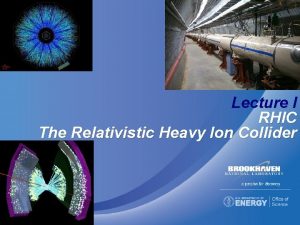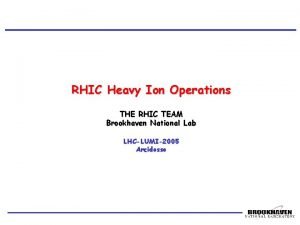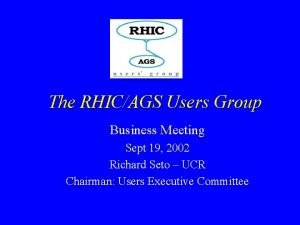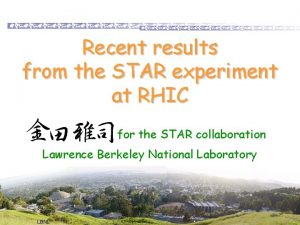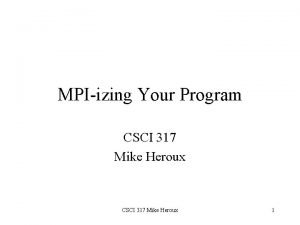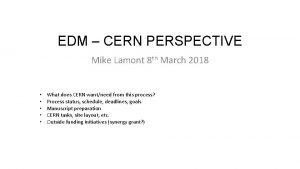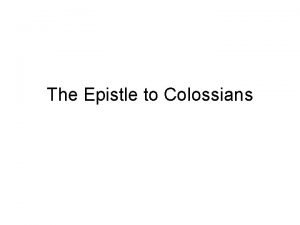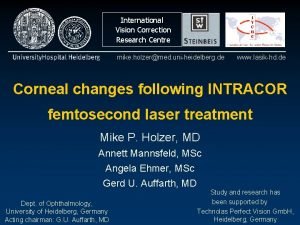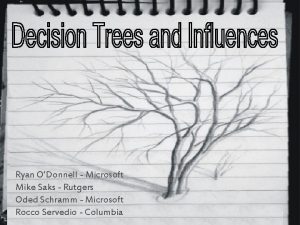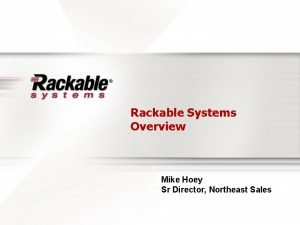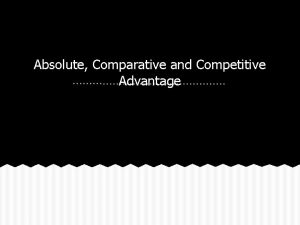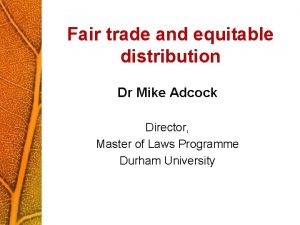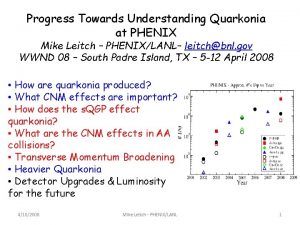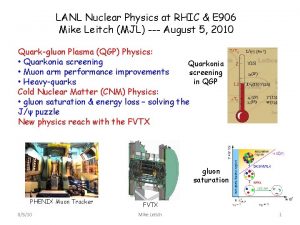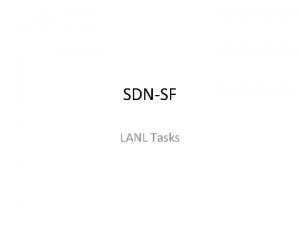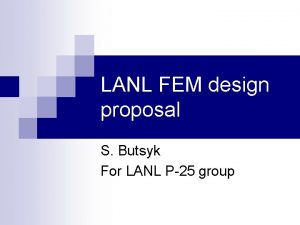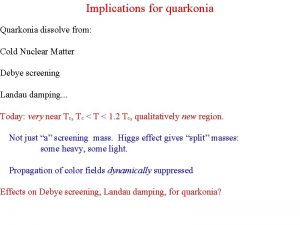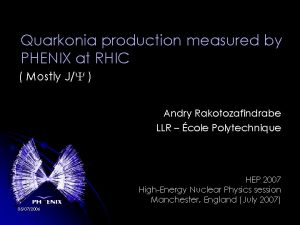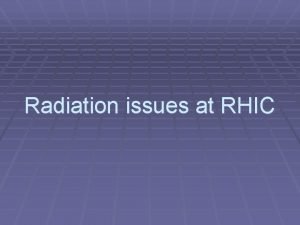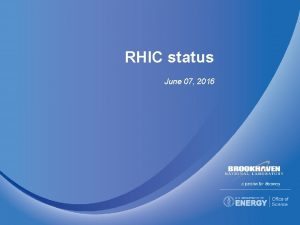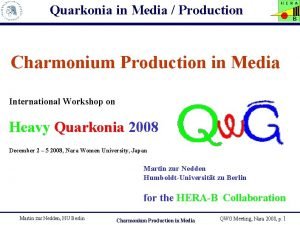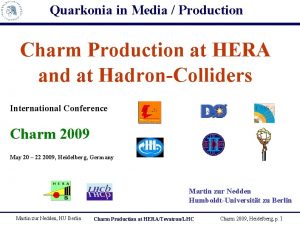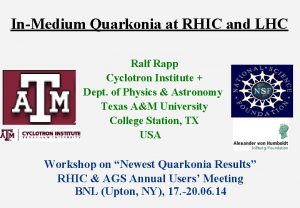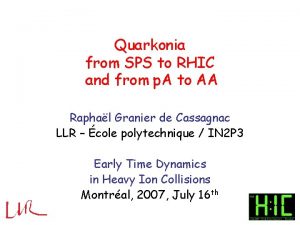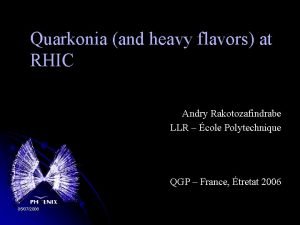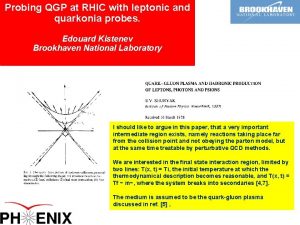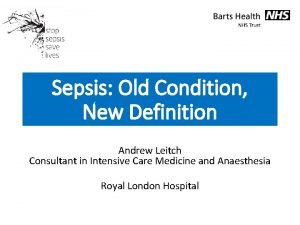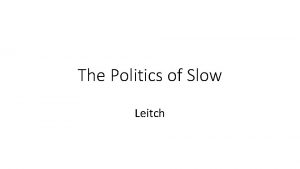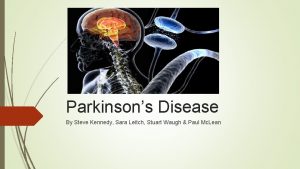Quarkonia Production at RHIC Mike Leitch LANL leitchlanl



























- Slides: 27

Quarkonia Production at RHIC Mike Leitch – LANL - leitch@lanl. gov SQM - UCLA – 26 -31 March 2006 § production § cross section & polarization § feed-down J/Ψ § cold nuclear matter § shadowing or gluon saturation § absorption E 789 § gluon energy loss = 15 Me. V § contrasting open & closed charm § initial-state p. T broadening § hot-dense matter in A-A collisions § PHENIX results § cold-nuclear matter effects in A+A § sequential suppression & regeneration § future prospects § summary Ψ’ 800 Ge. V (see also talks by Johan Gonzalez, Andry Rakotozafindrabe, Andrew Glenn) 10/6/2020 Mike Leitch 1

J/ψ production, parton level structure & dynamics Production of heavy vector mesons, J/ , ’ and Gluon fusion dominates (NLO calculations add more complicated diagrams, but still mostly with gluons) • production: color singlet or octet cc: absolute cross section and polarization? Phys. Rev. C 61 (2000) 035203 Hadronization time (important for p. A nuclear effects) Complications due to substantial feed-down from higher mass resonances, from ’, c 10/6/2020 χ, 1, 2 J/ ~30% ΄ J/ 5. 5% Mike Leitch s=39 Ge. V 2

J/ψ Production - Polarization E 866/Nu. Sea very small J/ψ polarization J/ψ Polarization PRL 91, 211801 (2003) NRQCD λ = +1 (transverse) = -1 (longitudinal) E 866 800 Ge. V x. F = x 1 – x 2 • Octet models get correct cross section size (unlike singlet), but… • CDF and Fermilab E 866 J/ψ data show little polarization & disagree with NRQCD predictions E 866/Nu. Sea – PRL 86, 2529 (2001) Drell-Yan 2 S+3 S 1 S But maximally polarized for (2 S+3 S), but NOT (1 S) · Is feed-down washing out polarization? (~40% of 1 S from feed-down) (also need ’ polarization measurement) 10/6/2020 Mike Leitch 3

PHENIX - J/ψ cross section vs rapidity & √s PRL 96, 012304 (2006) √s = 200 Ge. V J/ p+p Pythia shape #J/ψ’s: ~400 ( ), ~100 (ee) Rapidity More pp J/ψ’s coming from PHENIX - ~5 k/arm in 2005 run ( ’ may be coming soon, at least for e+e-, but higher luminosities will be needed to get significant # of counts) 10/6/2020 Mike Leitch 4

Nuclear effects on Onia Production Modification of parton momentum distributions of nucleons embedded in nuclei • shadowing – depletion of low-momentum partons (gluons) • coherence & dynamical shadowing • gluon saturation at small x – e. g. Color Glass Condensate (CGC) model Eskola, Kolhinen, Vogt, NP A 696, 729 (2001) 800 Ge. V p-A (FNAL) A = p*A Nuclear effects on parton “dynamics” • absorption (or disassociation) of J/ψ by nucleons or co-movers • energy loss of partons as they propagate through nuclei • multiple scattering effects (Cronin effect) causing p. T broadening 10/6/2020 Mike Leitch PRL 84, 3256 (2000); PRL 72, 2542 (1994) open charm: no A-dep at mid-rapidity = x 1 -x 2 5

Gluon Shadowing and Saturation 10 Ge. V 5 Ge. V Q = 2 Ge. V Leading twist gluon shadowing, e. g. : • Gerland, Frankfurt, Strikman, Stocker & Greiner - Eur. Phys. J A 5, 293 (1999) • phenomenological fit to DIS & Drell-Yan data, Eskola, Kolhinen, Vogt – Nucl. Phys. A 696, 729 (2001). • and many others Amount of gluon shadowing differs by up to a factor of three between diff models! high x 10/6/2020 low x Saturation or Color Glass Condensate (CGC) • At low-x there are so many gluons that 2 1 diagrams become important and deplete low-x region • Nuclear amplification: x. AG(x. A) = A 1/3 xp. G(xp), i. e. gluon density is ~6 x higher in Gold than the nucleon Mike Leitch 6

The J/ - a Cold Nuclear Matter (CNM) Puzzle J/ suppression is a puzzle with possible contributions from shadowing & from: 800 Ge. V p-A (FNAL) PRL 84, 3256 (2000); PRL 72, 2542 (1994) Energy loss of incident gluon shifts effective x. F and produces nuclear suppression which increases with x. F open charm: no A-dep at mid-rapidity Hadronized J/ψ? Absorption (or dissociation) of into two D mesons by nucleus or co-movers (the latter most important in AA collisions where co-movers more copious) Intrinsic charm components of incident proton produce J/ at large x. F. A 2/3 dependence from surface stripping of proton’s light quarks (Brodsky) 10/6/2020 • J/Ψ and Ψ’ similar at large x. F where they both correspond to a traversing the nucleus • but Ψ’ absorbed more strongly than J/Ψ near mid-rapidity (x. F ~ 0) where the resonances are beginning to be hadronized in nucleus • open charm not suppressed at x. F ~ 0; what about at higher x. F? Mike Leitch 7

Transverse Momentum Broadening for J/ψ’s PRL 96, 012304 (2006) High x 2 ~ 0. 09 Initial-state gluon multiple scattering causes p. T broadening (or Cronin effect) PHENIX 200 Ge. V results show p. T broadening comparable to that at lower energy ( s=39 Ge. V in E 866/Nu. Sea) Upsilons Low x 2 ~ 0. 003 Drell-Yan J/Y & Y’ 10/6/2020 Mike Leitch 8

PHENIX J/ Nuclear Dependence for 200 Ge. V pp and d. Au collisions – PRL 96, 012304 (2006) J/ for different s collisions Low x 2 ~ 0. 003 (shadowing region) 200 Ge. V something more, d. E/dx? open charm: no A-dep at mid-rapidity & more? 19 Ge. V 39 Ge. V = X 1 – X 2 Klein, Vogt, PRL 91: 142301, 2003 Kopeliovich, NP A 696: 669, 2001 Data favors weak shadowing & absorption • With limited statistics difficult to disentangle nuclear effects • Will need another d. Au run! (more pp data also) 10/6/2020 Not universal vs x 2 as expected for shadowing, but does scale with x. F, why? • initial-state gluon energy loss? • Sudakov suppression (~energy conservation)? Mike Leitch 9

Au. Au J/ψ’s - Quark Gluon Plasma (QGP) signature? Debye screening predicted to destroy J/ψ’s in a QGP with different states “melting” at different temperatures due to different binding energies. NA 50 anomalous suppression Survival probability corrected for normal absorption but recent regeneration models might give enhancement that compensates for screening? Karsch, Kharzeev, Satz sum n regeneratio screening 10/6/2020 on the other hand, recent lattice calculations suggest J/ψ not screened after all. Suppression only via feed-down from screened C & ’ Mike Leitch energy density 10

J/ suppression in AA collisions & CNM baseline (CNM = Cold Nuclear Matter) 0 mb 3 mb 0 mb Low x 2 ~ 0. 003 (shadowing region) 3 mb • CNM calculations with shadowing & absorption • present d. Au data probably only constrains absorption to: σABS ~ 0 -3 mb 10/6/2020 R. Vogt CNM calcs. periph. central • AA suppression is somewhat stronger than CNM calculations predict • but really need more precise d. Au constraint! Mike Leitch 11

Models without regeneration QGP sequential screening ’, J/ comovers Digal, Fortunato, Satz hep-ph/0310354 Capella, Sousa EPJ C 30, 117 (2003) Capella, Ferreiro hep-ph/0505032 Models that reproduce NA 50 results at lower energies predict too much suppression at RHIC! • Satz - color screening in QGP (percolation model) with CNM added (EKS shadowing + 1 mb) • Capella – comovers with normal absorption and shadowing • Rapp – direct production with CNM effects needs very little regeneration to match NA 50 data 10/6/2020 Mike Leitch total Grandchamp, Rapp, Brown hep-ph/0306077 direct regeneration J/ , ’, c Rapp Capella Satz 12

Models with screening & regeneration Models with regeneration, i. e. single charm quarks combining in the later stages to form J/ ’s – match the observed RHIC suppression much better! • but the regeneration goes as - which is still poorly known at RHIC (& that’s another story. . ) Thews Eur. Phys. J C 43, 97 (2005) statistical hadronization model hep-ph/0311048 (CERN yellow rpt) 10/6/2020 Grandchamp, Rapp, Brown PRL 92, 212301 (2004) Mike Leitch 13

Many More Models for RHIC J/ suppression in Cu. Cu & Au. Au Collisions All have suppression + various regeneration mechanisms Rapp - PRL 92, 212301 (2004) • screening & in-medium production Thews – see previous slide Andronic - PL B 57, 136 (2003) • statistical hadronization model • screening of primary J/ ’s • + statistical recombination of thermalized c-cbar’s Kostyuk – PRC 68, 041902 (2003) • statistical coalescence • + comovers or QGP screening Bratkovskaya – PRC 69, 054903 (2004) • hadron-string dynamics transport Kostyuk Andronic Rapp Zhu Bratkovskaya Zhu - PL B 607, 107 (2005) • J/ transport in QGP • co-movers, gluon breakup, hydro for QGP evolution • no cold nuclear matter, no regeneration 10/6/2020 Mike Leitch 14

Regeneration or Sequential Screening? RHIC suppression looks same as that at NA 50 • but ~10 x collision energy & ~2 -3 x gluon energy density at RHIC • regeneration compensates for stronger QGP suppression? • if so, regeneration would be huge at the LHC! ------- OR ----------(Karsch, Kharzeev, Satz, hep-ph/0512239) • Sequential screening of the higher-mass resonances that feed-down to the J/ ; with the J/ itself still not dissolved? • supported by recent Lattice calculations that give TJ/ > 2 TC Quarkonium dissociation temperatures – Digal, Karsch, Satz 10/6/2020 Mike Leitch 15

Regeneration should cause narrowing of p. T and y – does it? But rapidity dependence of central AA collisions (top panels) shows no narrowing – i. e. peaked ratios as in the Thews (maximal) regeneration, shown below But careful – is ccbar flatter with y than we originally thought? di re ct p. T broadening lies in between Thews direct & in-medium formation suggesting some regeneration (but our fit to pp+d. Au data vs L also reasonable) CNM ation regener <p. T 2> = 2. 51+0. 32*L from fit to d. Au data vs L 10/6/2020 Mike Leitch 16

Flow of J/ ’s? Need to look for J/ flow – if regeneration dominates, the J/ ’s should inherit flow from charm quarks • open charm has recently been seen to flow (at least at some p T values) • but what about geometrical absorption effects, which could also give asymmetry wrt reaction plane? coalescence of thermalized charm X 0. 1 (Rapp) only y r t e geom PRC 72, 024906 (2005) Zhu et al. PL B 607, 107 (2005) 10/6/2020 Mike Leitch 17

Much More to Come! Ultra-peripheral Collisions (UPC’s) QM 05 1 st Upsilons at RHIC from ~3 pb-1 collected during the 2005 run. 10/6/2020 UPC’s : well calibrated EM probe of small-x gluon saturation Mike Leitch 18

STAR Preliminary J/ Run 4 Au. Au J. Gonzalez, SQM Onia in STAR Preliminary J/ Run 5 pp Dielectron Invariant Mass (Ge. V/c 2) STAR Au. Au preliminary Dielectron Invariant Mass (Ge. V/c 2) Signal RHIC Exp. (Au+Au) RHIC I (>2008) RHIC II LHC ALICE+ J/ →e+e. J/ → + - PHENIX 3, 300 29, 000 45, 000 395, 000 9, 500 740, 000 → e+ e → + - STAR PHENIX 830 80 11, 200 1, 040 2, 600 8, 400 10/6/2020 Mike Leitch 19

Summary Progress on onia production cross sections and polarization but still not well understood • causes uncertainties in the understanding of nuclear effects (e. g. J/ψ absorption) Weak shadowing has been observed at RHIC for the J/ψ in d. Au collisions • but scaling with x. F (and not with x 2) is still a puzzle AA collisions at RHIC suggest substantial contributions from regeneration • suppression observed is very similar to NA 50 at lower energies but more suppression would be expected from QGP since gluon densities are 2 -3 x larger at RHIC Sequential screening, where c & ’ are screened but J/ is not (consistent with Lattice calculations), provide a simpler picture • need more accurate d. Au data to establish level of CNM effects in AA • need accurate open charm cross section & J/ flow measurement to constrain regeneration models 10/6/2020 Mike Leitch 20

PHENIX Run 6 (present) J/ ’s in forward/backward Muon arms (from near-online analysis using trigger-filtered events) North South 10/6/2020 Mike Leitch 21

ALL vs p. T First spin physics result from J/ Log(x) - J/ : produced via almost pure gluon fusion - sensitive to gluon polarization 10/6/2020 Mike Leitch 22

RHIC-II - Quarkonia – With detector upgrades (PHENIX and STAR): • J/ from B decays with displaced vertex measurement (both). • Reduce J/ →μμ background with forward μ trigger in PHENIX. • Improve mass resolution for charmonium and resolve family. • See in forward calorimeter in front of muon arms (PHENIX) and in FMD in STAR – And with the luminosity upgrade: • J/ RAA to high p. T. Does J/ suppression go away at high p. T? • J/ v 2 measurements versus p. T. See evidence of charm recombination? • RAA. Which Upsilons are suppressed at RHIC? • Measure c → J/ + RAA. Ratio to J/ ? • Measure ’ RAA. Ratio to J/ ? • Measure B → J/ using displaced vertex - independent B yield measurement, also get background to prompt J/ measurement. 10/6/2020 Mike Leitch 23

RHIC-II - Heavy Flavor Yields Signal All numbers are first rough estimates (including trigger and reconstruction efficiencies) for 12 weeks Au+Au run (∫Leff dt ~ 18 nb-1) RHIC Exp. Obtained RHIC I (>2008) RHIC II LHC/ALICE+ J/ →e+e. J/ → + - PHENIX ~800 ~7000 3, 300 29, 000 45, 000 395, 000 9, 500 740, 000 → e+ e → + - STAR PHENIX - 830 80 11, 200 1, 040 2, 600 8, 400 B→J/ →e+e. B→J/ → + - PHENIX - 40 420 570 5, 700 N/A c→e+e- c→ + - PHENIX - 220 2, 900* 8, 600 117, 000* N/A 30, 000** 8000 D→Kp STAR ~0. 4× 106 (S/B~1/600) T. Frawley, PANIC’ 05, * Large backgrounds, quality uncertain as yet RHIC-II Satellite Meeting ** Running at 100 Hz min bias + 1 month (= year), P. Crochet, EPJdirect A 1, a (2005) and private comm. 10/6/2020 Mike Leitch 24

Onia Yields at RHIC II pp (200 Ge. V) 55, 054 993 100 1, 340 2, 190 210 1, 237 pp (500 Ge. V) 609, 128 10, 985 2, 578 40, 870 59, 296 3, 032 41, 480 Cu. Cu (200 Ge. V) 73, 921 1, 333 134 1, 800 2, 941 547 4, 567 468, 741 5, 483, 006 653, 715 394, 535 258, 136 Y′(2 S) mm 8, 453 98, 880 11, 789 7, 115 4, 655 _c 0 g+J/Y mm 3, 822 99, 824 5, 330 3, 217 2, 105 _c 1 g+J/Y mm 51, 215 1, 582, 561 71, 425 43, 107 28, 204 _c 2 g+J/Y mm 83, 702 2, 296, 069 116, 732 70, 451 46, 095 (0, 1, 2) mm 528 7, 723 1, 429 1, 035 469 B J/Y mm 2079 76466 5756 3752 1824 Signal/System J/Y ee Y′(2 S) ee _c 0 g+J/Y ee _c 1 g+J/Y ee _c 2 g+J/Y ee (0, 1, 2) ee B J/Y ee Au. Au (200 Ge. V) 44, 614 805 81 1, 086 1, 775 397 3, 572 d. Au (200 Ge. V) 29, 919 540 54 728 1, 190 184 1, 085 J/Y mm • • • Precision measurements of the J/ Exploratory measurements of the other onium states. Steep increase at √s = 500 Ge. V illustrates the significant difficulties for measurements at lower energies. 10/6/2020 Mike Leitch 25

Feeding of J/ψ’s from Decay of Higher Mass Resonances Large fraction of J/ψ’s are not produced directly HERA-B Phys. Lett. B 561 (2003) 61 -72 & E 705 @ 300 Ge. V/c, PRL 70, 383 (1993) R. Vogt, NRQCD calculations Nucl. Phys. A 700 (2002) 539 C let g sin t cte o Ψ’ direct J/ψ HERA-B x. F range 920 Ge. V All J/ψ’s Proton Pion χ, 1, 2 J/Ψ ~30% 37% Ψ΄ J/Ψ 5. 5% 7. 6% Effect on Nuclear dependence: • Nuclear dependence of parent resonance, e. g. χC is probably different than that of the J/ψ • e. g. in proton production ~21 -30% of J/ψ’s will have different effective absorption because they were actually χC’s while in the nucleus = m -m. J/ 10/6/2020 Mike Leitch 26

Contrasting ’s with J/ψ’s √S =39 Ge. V (E 772 & E 866) • less absorption • not in shadowing region (large x 2) • similar p. T broadening • 2 S+3 S have large transverse polarization - unlike 1 S or J/ψ (as was shown earlier) Upsilons But careful: suppression is from data for x. F < 0 or x 2 > 0. 2 (in the EMC region) 1 S 2 S+3 S Drell-Yan J/Y & Y’ 10/6/2020 Mike Leitch 27
 Lanl
Lanl Lanl org chart
Lanl org chart Rhic
Rhic Rhic brookhaven
Rhic brookhaven Rhic ags users meeting 2020
Rhic ags users meeting 2020 Rhic
Rhic Arti post production
Arti post production Mike heroux
Mike heroux Mike lamont cern
Mike lamont cern Mike mazzalongo
Mike mazzalongo Mike mazzalongo wife
Mike mazzalongo wife Mike roberts cpa
Mike roberts cpa Mike cohn user stories
Mike cohn user stories Mike mazzalongo wikipedia
Mike mazzalongo wikipedia Mike p. holzer
Mike p. holzer Mike mazzalongo statement of faith
Mike mazzalongo statement of faith Mike saks
Mike saks Mike schwert
Mike schwert Mike eberhard
Mike eberhard Mike eldon
Mike eldon Mike veverka
Mike veverka Mike mazzalongo biography
Mike mazzalongo biography Ppmb's taxonomy
Ppmb's taxonomy Mike hoey
Mike hoey What is mike's opportunity cost of vacuuming
What is mike's opportunity cost of vacuuming Mike durand strength coach
Mike durand strength coach Mike adcock durham university
Mike adcock durham university Michael basher
Michael basher
